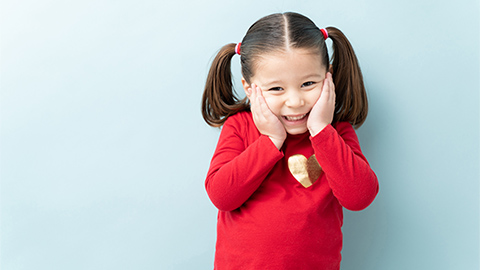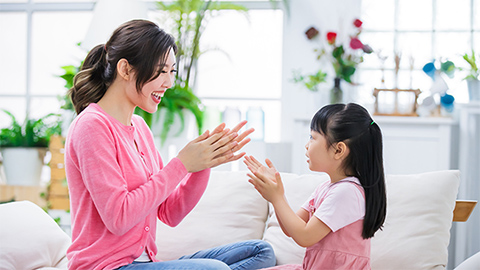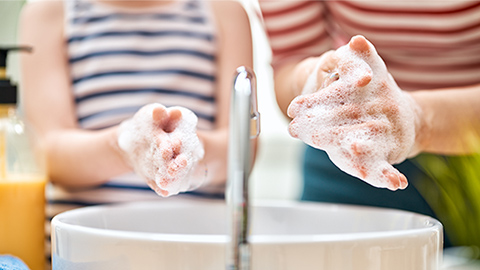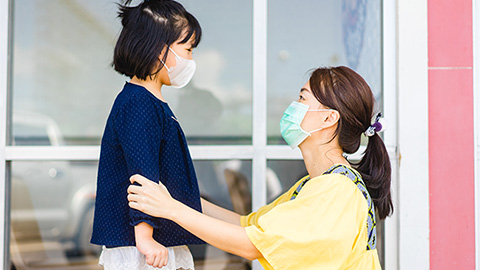
If there’s one habit our little ones can’t seem to kick, it’s touching their face: from rubbing their eyes, to putting fingers in their mouth, to picking their nose! While these may seem harmless, they are highly discouraged by our medical experts.
Every instance increases the probability of catching and spreading COVID-191. So, what’s the best way to teach our kids to stop this habit, especially when they don’t want to listen? Here are a few things you can try.
1. Use positive reinforcement instead of correcting them.
Children tend to respond better to positive reinforcement than criticism or correction.2 Praise them for a job well done instead of telling them to stop doing the deed. Each time they successfully stop themselves from touching their faces, try giving them compliments or small rewards such as stickers, toys or treats.
Compliment them by saying things like “I like that you are not touching your face right now”. These behaviors are more likely to happen when followed by a positive consequence or a reward. This way, you can encourage your child’s good behavior, bolster their self-esteem, and most importantly, strengthen your relationship with them.2

2. Point Out When They Are Doing It
Combined with positive reinforcement, you can candidly point out when your children are touching their face. Make sure you use a calm voice when doing so. Repetition breeds awareness! And don’t forget: As parents, it’s best to lead by example. When you practice what you preach, your child is more likely to follow!
3. Give Them Something Else to Touch
Just like adults, our little ones are more likely to touch their faces when their hands are free. When this happens, you can try giving your child a toy they can hold to or spend time with them with hands-on activities, like puzzles, painting or drawing. This can help divert your child’s attention, and keep their hands busy.
Just make sure to keep an eye on your littlest ones to ensure they don’t put anything in their mouths.
4. Educate them about germs
One powerful way of preventing coronavirus infections is soap.3 While children may be too young to know the science behind germs, you can always show them how germs work in a fun way with age-appropriate experiments and activities like the “Pepper and Salt Trick”.
By doing this, they can better understand the reasons behind your requests, and why they are so important!
5. Make sure they wash their hands!

Now that they know how germs work, it’s time to introduce them to the power of handwashing! Make hand washing a family activity4, and follow this step-by-step process:
- Wet hands with water. Put soap on your hands and make suds!
- Clean palms, the back of hands and between your fingers. (Ask your kids to sing ‘Happy Birthday’ twice while doing this!)
- Don’t forget to clean under your nails.
- Then, rinse with clean running water.
- Shake and dry your hands with a clean towel.
Remind them to wash their hands before eating, after going to the bathroom, and after playing with pets and toys. With this simple act, we are already minimizing the spread of the virus.
Remember to be patient with your kids and use good communication. By teaching them proper hygiene, you aren’t just protecting them from the virus; you’re future-proofing them too!
For more information about COVID-19, you may visit this link.
References:
1 World Health Organization. 8 April 2020. Q&A on coronaviruses (COVID-19)
https://www.who.int/news-room/q-a-detail/q-a-coronaviruses
2Centers for Disease and Control and Prevention. 5 November 2019. Essentials for Parenting Toddlers and Preschoolers: How to Use Rewards
https://www.cdc.gov/parents/essentials/directions/important.html
3Centers for Disease and Control and Prevention. 13 April 2020. Coronavirus Disease 2019 (COVID-19): Caring For Children
https://www.cdc.gov/coronavirus/2019-ncov/daily-life-coping/children.ht…
4Centers for Disease and Control and Prevention. 13 April 2020. Handwashing: Clean Hands Save Lives
https://www.cdc.gov/handwashing/handwashing-family.html

